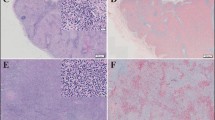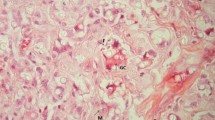Summary
We compared the paracortical area in 4 cases of dermato-pathic lymphadenitis (DL) with the same area in 11 cases of various other reactive conditions of the lymph node by immuno- and enzymehis-tochemical techniques. In addition, electron microscopy was performed on threee cases of DL. The paracortical nodules in DL proved to be composed of a variable number of dendritic, OKT6+ OKIa+ ATP-ase+ cells, admixed with helper T-lymphocytes. All other lymph nodes studied lacked dendritic OKT6+ cells, whereas OKIa positivity was found in the cortical (follicular centers and mantle zones) and paracortical area (lymphocytes and scattered dendritic cells). Short incubation for ATPase revealed a paracortical, pericellular staining pattern in cases of DL, whereas in all other cases this staining pattern was observed only after long incubation times. On electron microscopy, three types of dendritic cells were found in DL, namely interdigitating reticulum cells (IDRC), Langerhans cells (LC) and macrophages. Intermediate forms between IDRC and LC, containing a few Birbeck granules and a well developed rough endoplasmic reticulum, were found.
It is suggested that immunoreactivity for the monoclonal antibody 0KT6 is restricted to cases of DL, and is due to the appearance of dendritic cells that have LC-characteristics. These cells either arrive from the skin along afferent lymph vessels, or are the result of a local transformation process of IDRC that acquire LC-characteristics, i.e. OKT6 immunoreactivity and Birbeck granules.
Similar content being viewed by others
References
Cocchia D, Michetti F, Donato R (1981) Immunochemical and immunocytochemical localization of S-100 antigen in normal human skin. Nature 294:85–87
Fithian E, Kung P, Goldstein G, Rubenfeld M, Fenoglio C, Edelson R (1981) Reactivity of Langerhans cells with hybridoma antibody. Proc Natl Acad Sci USA 78:2541–2544
Gomori G (1952) Microscopic histochemistry: principle and practice. Chicago University Press, Chicago, p 193
Goos M, Müller-Hermelink HK (1975) Dermatopathic lymphadenitis-an alteration of T-lymphocyte areas in skin related lymph node. 2nd Eur Meet on Electron Microscopy Applied to Cutaneous Pathology, Milano, Jan 17–18
Hendriks E, Balfour BM, Kamperdijk EWA, Cvetano J (1979) Cell containing Birbeck granules in lymph and lymph nodes. In: Rucholtz WM, Müller-Hermelink HK (eds) Function and structure of the immune system advances in experimental medicine and biology, vol 114. Plenum Press, New York, p 321
Kamperdijk EWA, Raaymakers EM, de Leeuw JHS, Hoefsmit ECM (1978) Lymph node macrophages and reticulum cells in the immune response. I. The primary response to paratyphoid vaccine. Cell Tissue Res 192:1–23
Kung PC, Goldstein G, Reinherz EL, Schlossman SF (1979) Monoclonal antibodies defining distinctive human T cell surface antigens. Science 206:347–349
Lampert IA, Pizzolo G, Thomas A, Janossy G (1980) Immunohistochemical characterization of cells involved in dermatopathic lymphadenopathy. J Pathol 131:145–156
Lennert K, in collaboration with Mohri N, Stain H, Kaiserling E, Müller-Hermelink HK (1978) Malignant Lymphomas other than Hodgkin’s Disease. Springer, Berlin Heidelberg New York Tokyo p 46
McMichael AJ, Pilch JR, Gafre G, Mason DY, Fabre JW, Milstein C (1979) A human thymocyte antigen defined by a hybrid monoclonal antibody. Eur J Immunol 9:205–210
Müller-Hermelink HK (1974) Characterization of the B-cell and T-cell region of human lymphatic tissue through enzyme histochemical demonstration of ATPase and 5′nucleotidase activities. Virchows Arch [Cell Pathol] 16:371–378
Poppema S, Bhan AK, Reinherz EL, McCluskey RT, Schlossman SF (1981) Distribution of T Cell subsets in human lymph nodes. J Exp Med 153:30–41
Rausch E, Kaiserling E, Goos M (1977) Langerhans cells and interdigitating reticulum cells in the thymus-dependent region in human dermatopathic lymphadenitis. Virchows Arch [Cell Pathol] 25:327–343
Reinherz EL, Kung PC, Goldstein G, Schlossman SF (1979) Further characterization of the human inducer T cell subset defined by a monoclonal antibody. J Immunol 123:2894–2896
Reinherz EL, Kung PC, Pesando JM, Ritz J, Goldstein G, Schlossman SF (1979) la determinants on human T-cell subsets defined by monoclonal antibody: activation stimuli required for expression. J Exp Med 150:1472–1482
Reinherz EL, Kung PC, Goldstein G, Levey RH, Schlossman SF (1980) Discrete stages of human intrathymic differentiation: Analysis of normal thymocyte and leukaemic lymphoblasts of T cell lineage. Proc Natl Acad Sci 77:1588–1592
Reinherz EL, Kung PC, Goldstein G, Schlossman SF (1980) A monoclonal antibody reactive with the human cytotoxic/suppressor T cell subset previously defined by a hetero-antiserum termed TH2. J Immunol 124:1301–1307
Rowden G, Lewis MG, Sullivan AK (1977) Ia antigen expression on human epidermal Langerhans cells. Nature 268:247–248
Shelley WB, Juhlin L (1976) Langerhans cells form a reticulo-epithelial trap for external contact antigens. Nature 461:46–47
Silberberg-Siniakin I, Thorbecke GJ, Baer RL, Rosenthal SA, Berezowsky V (1976) Antigenbearing Langerhans cells in skin, dermal lymphatics and in lymph nodes. Cell Immunol 25:137–151
Stingl G, Katz SI, Abelson LD, Mann DL (1978) Immunofluorescent detection of human B cell alloantigens on s-Ig-positive lymphocytes and epidermal Langerhans cells. J Immunol 120:661–664
Stingl G, Katz SI, Clement L, Green I, Shevach EM (1978) Immunologic functions of labearing epidermal Langerhans cells. J Immunol 121:2005–2013
Takahashi K, Yamaguchi H, Ishizeki J, Nakajima T, Nakazato Y (1981) Immunohistochemical and Immunoelectron Microscopic Localization of S-100 Protein in the Interdigitating Reticulum Cells of the Human Lymph Node. Virchows Arch [Cell Pathol] 37:125–135
Wolff K (1972) The Langerhans Cell. Curr Probl Dermatol 4:79–145
Author information
Authors and Affiliations
Rights and permissions
About this article
Cite this article
van den Oord, J.J., de Wolf-Peeters, C., de Vos, R. et al. The paracortical area in dermatopathic lymphadenitis and other reactive conditions of the lymph node. Virchows Archiv B Cell Pathol 45, 289–299 (1984). https://doi.org/10.1007/BF02889871
Received:
Accepted:
Issue Date:
DOI: https://doi.org/10.1007/BF02889871




